Pressure reduction in the supply system
Remove the No. 9 fuse (fuel pump fuse) from the right fuse box.
Start the engine and let it run until the fuel line runs out of fuel.
The engine will then stop.
Insert the fuse.
Replace damaged chain guides.
After that, you can disconnect the fuel lines.
Replacing the Mass Air Flow Sensor
Disconnect the wire from the "negative" terminal of the battery.
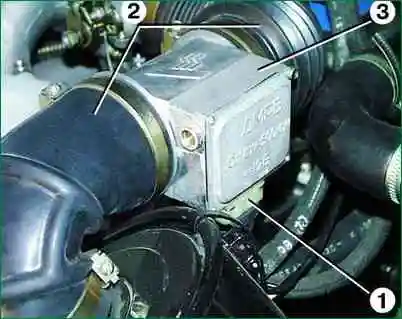
Disconnect connector 1 from mass air flow sensor 3.
Loosen the clamps, disconnect the air supply hoses 2 and remove the sensor 3.
Install the new sensor in reverse order.
Checking the Mass Air Flow Sensor
Remove the mass air flow sensor.
Connect a voltmeter to pins "2" and "3" of the sensor connector.
Submit 12 V DC to pins "1" and "5" to pin 5, and minus to pin 1.
At the same time, the voltmeter should show a voltage of 1.3-1.4 V.
Then briefly close contacts "4" and "5" between each other.
The voltmeter should at the same time show a voltage of about 8 V, and the platinum thread should become red-hot. If at least one of these conditions is not met, replace the sensor.
Adjusting the content of carbon monoxide (CO) in exhaust gases
The adjustment is made on a warm engine (coolant temperature 80-90 ° C) with a working ignition system and nominal gaps between the spark plug electrodes.
The content of CO and CH in the exhaust gases should be within:
- 0.7–0.9% CO and 1200 min –1 CH at crankshaft speed (800±50) min –1 ;
- no more than 0.5% CO and 600 min –1 CH at an engine speed of (3150±50) min –1 .
If the CO content is above the specified limits, adjust the CO content with screw 1 on the mass air flow sensor.
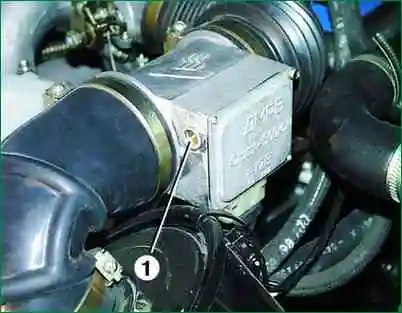
Turning the screw clockwise increases the CO content, while turning it counterclockwise decreases it.
This will also adjust the CH content.
If it is not possible to adjust the content of CO and CH within the specified limits, it is necessary to check the serviceability of the elements of the integrated microprocessor engine control system.
Replacing the accelerator cable
Disconnect the wire from the "Negative" battery terminal.

Remove nut 1 and remove accelerator cable 2 from sector 3 of the air throttle actuator.
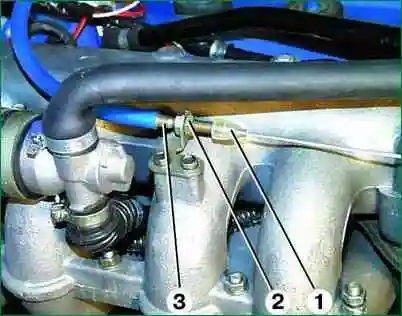
Slide gland 1 off the cable tip, completely unscrew nut 2 from the cable tip, pull tip 3 of the cable sheath out of the bracket and pull it up out of the bracket through the cable slot.
Remove the tip 3 from the cable, removing it from the outer 4 and inner shells of the cable.
Remove the outer 1 and inner sheaths of the cable from the tip 2 on the bulkhead
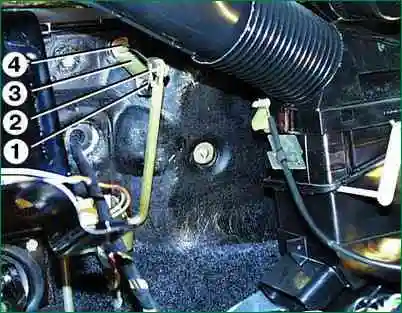
Remove cotter pin 1 from pin and remove pin 2.
Slide oil seal 4 and remove bracket 3.
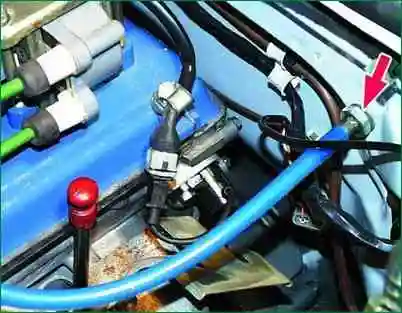
Pull the cable through the tip on the bulkhead shield into the passenger compartment.
Install the new accelerator cable in reverse order and adjust it.
Adjusting the throttle cable

Loosen the nut 1 fastening the cable 2 on sector 3.
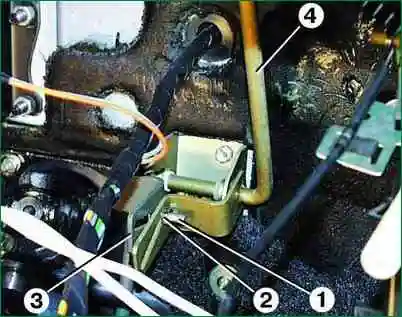
Loosen the nut 2 of the adjusting bolt 1 between the upper 4 and lower 3 accelerator pedal levers.
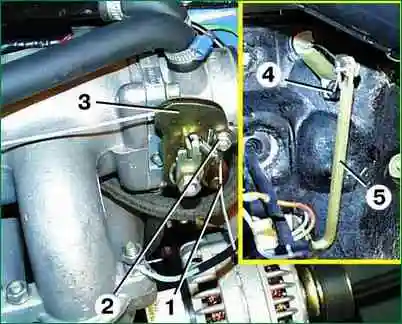
From the side of throttle sector 3, pull out cable 1 as far as it will go.
In this case, the upper lever 5 of the accelerator pedal must rest against the buffer 4 on the bracket.
Tighten nut 2 securing the cable on the sector.
The throttle valve must be fully closed.

Retract the upper lever 4 of the pedal to the stop.
While holding the upper lever 4 of the pedal in this position, turn the lower lever 3 of the pedal until it stops on the mat and tighten the nut 2 of the adjusting bolt 1
When properly adjusted, with the pedal fully released, the throttle should be fully closed and the upper pedal arm should rest against the buffer on the bracket.
With the pedal fully depressed, the throttle should be fully open and the lower pedal arm should rest against the mat.
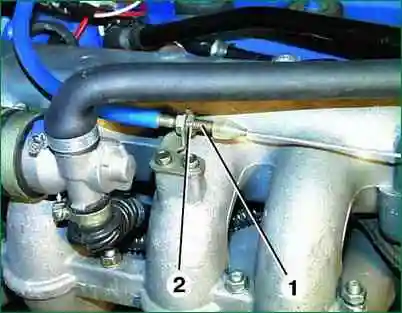
You can correct the position of the cable by moving the tip 1 of the sheath in the bracket, loosening the tightening of the nut 2. After adjusting the nut 2, tighten it.
Removing the throttle body
Disconnect the wire from the "negative" terminal of the battery.
Disconnect the accelerator cable from the throttle sector
Disconnect connector 1 with wires from throttle position sensor.
Loosen the clamps and disconnect the idle speed control 2 and crankcase ventilation hoses 3.
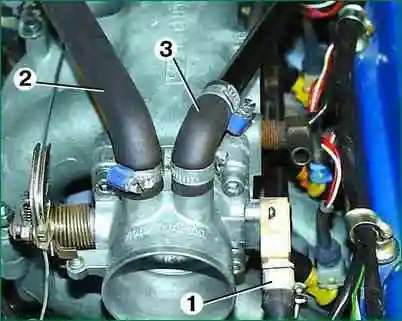
Loosen the clamps and disconnect the throttle heating hoses 1, having previously marked them.
Immediately plug the hoses with plugs to prevent loss of coolant.
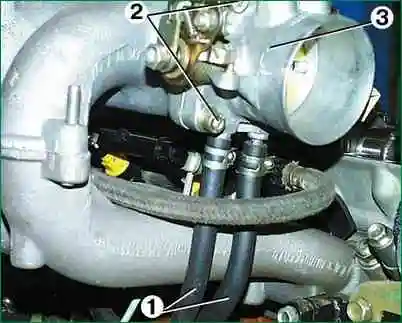
Remove the four mounting bolts 2 and remove the throttle 3 with the gasket.
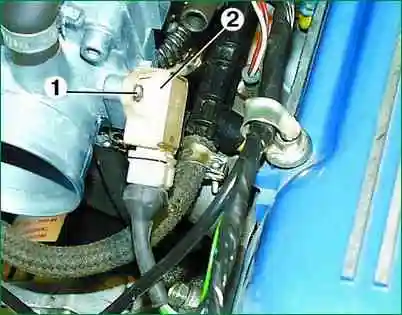
If it is necessary to remove the throttle position sensor 2, unscrew the two screws 1 securing it.
Idle speed regulator replacement
Disconnect the wire from the "negative" terminal of the battery.
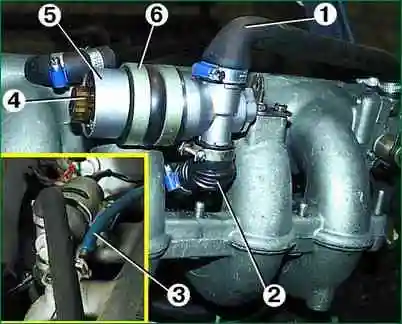
Loosen the clamps and disconnect hoses 1 and 2 from the regulator 5. Disconnect the block with wires from the connector 4 of the regulator.
Remove the two mounting bolts 3 and remove the regulator. Remove regulator 5 from clamp 6.
Install the new idle control in reverse order.
Checking the idle speed control
Remove the idle speed control.
Submit 12 V DC to the middle pin of the regulator connector and alternately to the side pins
This should rotate the shutter to open or close the inlet port. If this does not happen, then the regulator is faulty and needs to be replaced.
Replacing nozzles
Reduce the pressure in the fuel system if the engine has just been stopped.
Disconnect the wire from the "negative" terminal of the battery.
Remove the receiver.
Loosen the clamps and disconnect the fuel supply hose 1 from the fuel line 3 of the engine.
Disconnect the fuel drain hose 4 from the pressure reducing valve.
Disconnect the pads with wires from the connectors 5 of the four injectors.
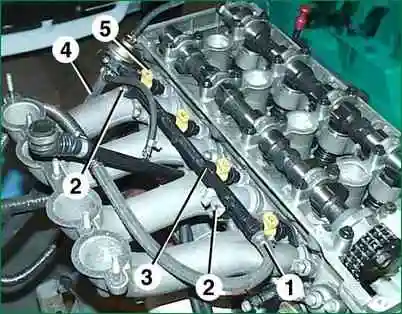
Remove the injector from the engine fuel line. The nozzle is fixed in the opening of the fuel line only with the help of a sealing ring tsa.
Unscrew the two fastening bolts 2 and carefully remove the fuel line 3 of the engine, removing the nozzles from the holes in the intake pipe.
Injectors are fixed in the intake pipe holes only with O-rings.
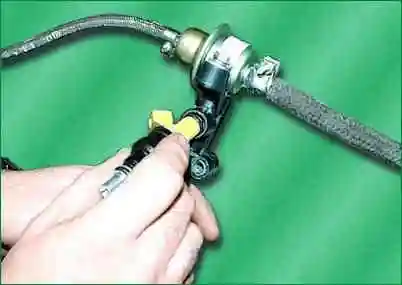
Install the new injector in reverse order.
Checking the injectors
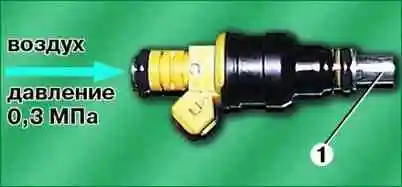
To check the tightness of the nozzle valve, lower the nozzle of the 1st nozzle into a container with gasoline or kerosene and apply compressed air at a pressure of 0.3 MPa (0.03 kgf/cm).
If air bubbles come out of the nozzle atomizer, then the nozzle valve is leaky and the nozzle needs to be replaced.
To check the health of the injector solenoid winding, apply 12 V DC to the injector connector.
In this case, a characteristic click should be clearly audible, which indicates the opening of the nozzle valve.
If this does not happen, then the nozzle is faulty and must be replaced. This test can be carried out without removing the nozzle from the vehicle.
The resistance of the injector solenoid winding can be checked with an ohmmeter by connecting it to the injector connector pins.
Resistance should be in the range of 15.5-16 ohms.
If the resistance value is not within the specified limits, replace the nozzle.
Replacing the pressure reducing valve
Depressurize the fuel system if the engine has just been shut down.
Disconnect the wire from the "negative" terminal of the battery.
Remove the engine fuel line.
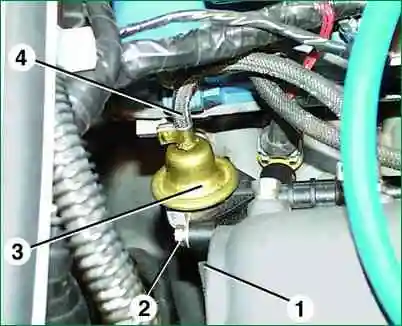
Disconnect fuel drain hose 1 and vacuum hose 4 from pressure reducing valve 3.
Remove two fastening bolts 2 and remove the pressure reducing valve 3 from the engine fuel line.
Install the new valve in reverse order.
Replacing and checking the timing sensor
Disconnect the wire from the "negative" terminal of the battery.
Disconnect the 3rd sensor wire block located behind the engine intake pipe.
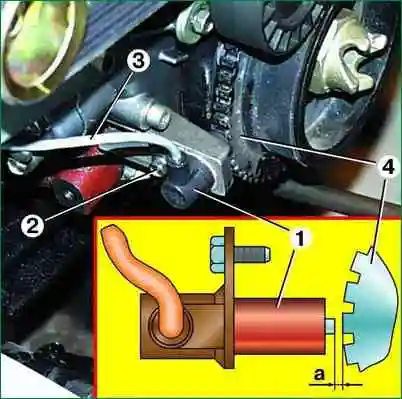
Remove bolt 2 and remove sensor 1.
Check the resistance of the sensor coil with an ohmmeter, it should be between 850 and 900 ohms.
If the resistance value is not within the specified limits, replace the sensor.
Install the sensor in reverse order.
For normal operation of the sensor, the gap "a" between sensor 1 and synchronization disk 4 must be within 1.0–1.5 mm.





